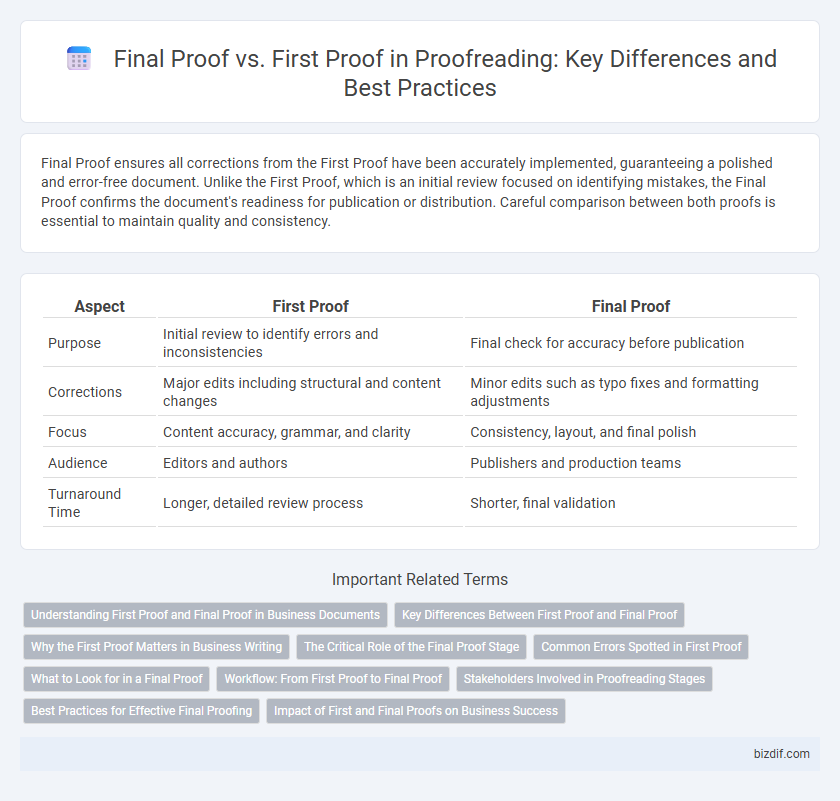Final Proof ensures all corrections from the First Proof have been accurately implemented, guaranteeing a polished and error-free document. Unlike the First Proof, which is an initial review focused on identifying mistakes, the Final Proof confirms the document's readiness for publication or distribution. Careful comparison between both proofs is essential to maintain quality and consistency.
Table of Comparison
| Aspect | First Proof | Final Proof |
|---|---|---|
| Purpose | Initial review to identify errors and inconsistencies | Final check for accuracy before publication |
| Corrections | Major edits including structural and content changes | Minor edits such as typo fixes and formatting adjustments |
| Focus | Content accuracy, grammar, and clarity | Consistency, layout, and final polish |
| Audience | Editors and authors | Publishers and production teams |
| Turnaround Time | Longer, detailed review process | Shorter, final validation |
Understanding First Proof and Final Proof in Business Documents
First Proof in business documents serves as the initial review stage, focusing on identifying and correcting errors in grammar, spelling, and formatting. Final Proof represents the last verification before publication or distribution, ensuring all revisions are accurately implemented and the document meets professional standards. Understanding both stages is crucial to maintain clarity, accuracy, and credibility in business communication.
Key Differences Between First Proof and Final Proof
The First Proof serves as the initial draft for review, highlighting major content errors and structural issues, whereas the Final Proof is the carefully revised version aimed at eliminating all typographical, grammatical, and formatting errors before publication. The First Proof often contains numerous annotations and corrections, while the Final Proof undergoes meticulous scrutiny to ensure consistency and accuracy. Key differences include the level of detail in corrections, the focus on content versus presentation, and the proof's readiness for final printing or distribution.
Why the First Proof Matters in Business Writing
The first proof in business writing serves as the critical foundation for identifying and correcting errors that can affect clarity, tone, and professionalism, setting the stage for a polished final document. It helps detect issues in grammar, punctuation, and formatting early, ensuring the message resonates effectively with the target audience. Prioritizing the first proof enhances accuracy and credibility, minimizing costly revisions in the final proof stage.
The Critical Role of the Final Proof Stage
The Final Proof stage serves as the ultimate checkpoint to catch any lingering errors or misalignments missed during the First Proof, ensuring the highest level of accuracy and quality. This phase involves meticulous examination of layout consistency, color fidelity, and text accuracy to guarantee the final product meets all printing specifications. By addressing these critical elements, the Final Proof stage significantly reduces costly revisions and enhances overall client satisfaction.
Common Errors Spotted in First Proof
Common errors spotted in the first proof include typos, grammatical mistakes, formatting inconsistencies, and incorrect punctuation. These initial proofs often reveal overlooked inaccuracies in spelling, citation errors, and misaligned text that require careful correction. Identifying and addressing these issues early ensures the final proof maintains high-quality, error-free content ready for publication.
What to Look for in a Final Proof
In a final proof, focus on catching any remaining typographical, grammatical, and formatting errors that may have been missed in the first proof. Verify that all corrections from previous rounds have been accurately implemented and check for consistency in fonts, spacing, and alignment. Pay close attention to page numbers, headers, footers, and any images or tables to ensure they appear correctly and completely formatted.
Workflow: From First Proof to Final Proof
The workflow from First Proof to Final Proof involves initial error detection and content verification during the First Proof stage, followed by iterative corrections and refinements. The Final Proof serves as the definitive review, ensuring all previously identified issues are resolved and the document meets publishing standards. This process enhances accuracy, clarity, and consistency before final approval.
Stakeholders Involved in Proofreading Stages
First proofs typically involve authors, editors, and designers who collaborate to identify and correct initial errors or formatting issues, ensuring the manuscript aligns with publication standards. Final proofs engage a broader group of stakeholders, including authors, professional proofreaders, and sometimes legal or compliance teams, to verify textual accuracy and adherence to regulatory requirements before printing or digital release. This multi-layered review process enhances the quality and correctness of the final published material.
Best Practices for Effective Final Proofing
Final proofing requires meticulous attention to detail, focusing on correcting typographical errors, formatting inconsistencies, and verifying design elements after the initial First Proof review. Best practices include reading the document multiple times, using a checklist tailored to common errors, and involving fresh eyes to catch overlooked mistakes. Ensuring a precise Final Proof minimizes costly revisions and upholds professional quality standards.
Impact of First and Final Proofs on Business Success
First proofs serve as crucial checkpoints for identifying and correcting errors, ensuring the content aligns with brand messaging and quality standards before mass distribution. Final proofs confirm all revisions have been implemented accurately, preventing costly mistakes that could damage brand reputation and customer trust. Effective management of both first and final proofs directly drives business success by enhancing product quality and fostering positive client relationships.
Final Proof vs First Proof Infographic

 bizdif.com
bizdif.com